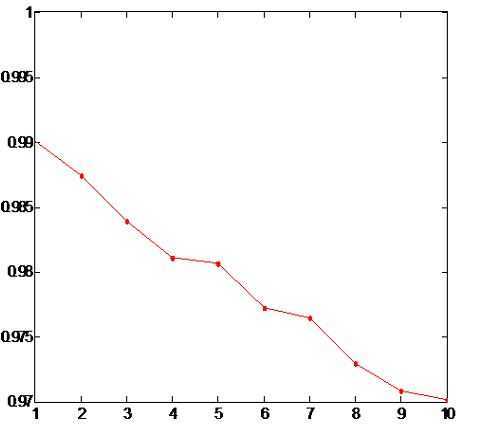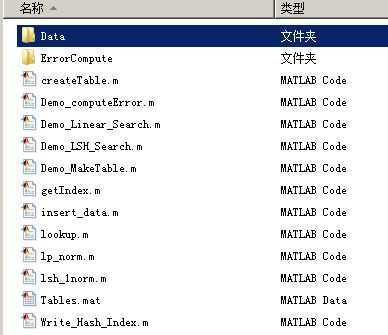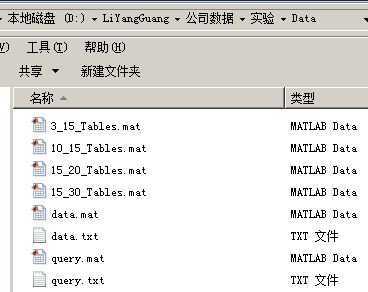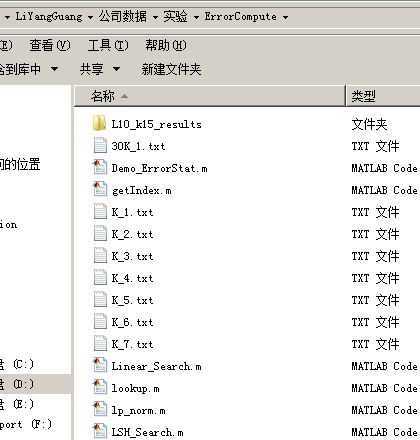标签:blog http color 使用 os io 数据 for
最开始仿真和精度测试,基于 matlab 完成的。
Demo_MakeTable.m (生成 Hash 表)
%========================================
%***********************************
%******* 设定参数: *****************
%******* l : hash表个数 ********
%******* k : 各表关键字个数 *******
%=========================================
clear all; close all; clc;
l = 3;
k = 15;
sData = textread(‘./Data/data.txt‘, ‘%s‘);
n = length(sData);
Data = false(n, 128);
for i = 1 : n
Data(i, :) = sData{i} - ‘0‘;
end
clear sData;
Tables = lsh_1norm(l, k, Data);
save([‘.\Data\‘ num2str(l) ‘_‘ num2str(k) ‘_Tables‘], ‘Tables‘);
% cd ./ErrorCompute
% Demo_ErrorStat
%% Write Hash keys and the Index
% 多线程
% matlabpool local 10
% for i = 1 : l
% fprintf(‘第 %d 个哈希表.\n‘, i);
% Write_Hash_Index(k, Tables(i), i);
% end
% matlabpool close
lsh_1norm.m (核心函数,我用其组织了整个索引结构生成过程)
function T2 = lsh_1norm(l, k, yy)
%==================================
% parameters setting && getting
% [n d] = size(x);
%==================================
%************ 数据集预处理 : 转 hamming 空间(维度小于100时使用) ********
% fprintf(‘数据集转换到 Hamming space.\n‘);
% tic
% x = x‘; % n x d (d < 100)
% C = max(x(:));
% dim = size(x);
% yy = false(dim(1), dim(2) * 255);
% for i = 1 : dim(1)
% for j = 1 : dim(2)
% oneO = false(1,C);
% oneO(1:x(i,j)) = 1;
% yy(i,(j-1)*C+1 : (j-1)*C+C) = oneO;
% end
% end
% clear oneO x;
% toc
% fprintf(‘转换 Hamming space 完成.\n‘);
%==================================
fprintf(‘初始化 %d 个 Hash 表...\n‘, l);
% matlabpool local 10
% 可并行
for i = 1 : l
% creat and init Tables[i] = f(k, x);
T1(i) = createTable(k, yy);
end
% matlabpool close
fprintf(‘初始化完成。\n‘);
%=====================================
tic;
matlabpool local 10
% save the index of feature data
% insert(T, x);
for i = 1 : l
fprintf(‘数据插入第 %d 个hash表\n‘, i);
T2(i) = insert_data(T1(i), yy);
end
matlabpool close
toc;
% clc;
%======================================
createTable.m
function T = createTable(k, x)
% M = size(x,1)+17; % length of second hashTable (hashTable2)
M = 587474;
d = size(x, 2);
select_d = unidrnd(d, 1, k);
I.d = select_d;
% I.threshold = unifrnd(0, 1, 1, k) * 255; % value interval [0 255]
I.k = k;
T.I = I;
T.randDigits = unidrnd(M, 1, k);
T.buckets = [];
T.index = {};
T.hashTable2 = cell(M,1);
insert_data.m
function T = insert_data(T, x)
% M = size(x, 1) + 17;
M = 587474;
% buck01 = x(T.I.d, :)‘ < repmat(T.I.threshold, size(x,2), 1);
buck01 = x(:, T.I.d);
[uBuck id1 id2] = unique(buck01,‘rows‘);
T.buckets = logical(uBuck);
T.bucket_cnt = length(id1);
key = mod(sum(bsxfun(@times, uBuck, T.randDigits),2), M) + 1; % matalb 下标从 1 开始
T.index = cell(length(id1), 1);
for bb = 1 : length(id1)
sameBucket = find(id2 == bb);
T.index{bb} = [T.index{bb}; sameBucket‘];
T.hashTable2{key(bb)} = [T.hashTable2{key(bb)} bb];
end
Demo_computeError.m (测试精确度)
% clear all; clc;
p = 1;
load([‘..\Data\3_15_Tables.mat‘]);
load(‘..\Data\data.mat‘);
load(‘..\Data\query.mat‘);
Data = Data‘;
avgErr = zeros(1, 50);
MissSum = zeros(1, 50);
picErr = zeros(1,50); picErr(1) = 0.982;
for K = 1 : 10
MissCnt = 0;
ratioCnt = 0;
fid = fopen([‘K_‘ num2str(K) ‘.txt‘], ‘w‘);
for i = 1 : length(Q) % the ith input.
% fprintf(fid, ‘%-5d‘, i);
% fprintf([num2str(i) ‘ ‘]);
q = Q(i,:)‘;
[Id1, Mis] = LSH_Search(q‘, K, Tables, Data, p);
if Mis
MissCnt = MissCnt + 1;
fprintf(fid, ‘Miss\n‘);
continue;
end
% num = num + 1;
% imwrite(uint8(input),[‘.\Data\‘,‘query_subset2\‘,num2str(num),‘.bmp‘]);
Id2 = Linear_Search(q, K, Data, p);
Dlsh = lp_norm(q, Data(:, Id1), p);
Dcst = lp_norm(q, Data(:, Id2), p);
id = Dlsh == Dcst;
ratio = Dcst ./ (Dlsh + 0.00002);
ratio(id) = 1;
% for j = 1 : K
% fprintf(fid, ‘%-8.2f‘, ratio(j));
% end
fprintf(fid, ‘error: %8.3f\n‘, ratio(K));
ratioCnt = ratioCnt + ratio(K);
end
fprintf(fid, ‘Hit times: %-5d Avg. error: %.3f\n‘, length(Q)-MissCnt, ratioCnt/(length(Q)-MissCnt));
avgErr(K) = ratioCnt/(length(Q)-MissCnt);
fprintf(fid, ‘Miss times: %-5d Miss ratio: %.3f‘, MissCnt, MissCnt/length(Q));
MissSum(K) = MissCnt;
picErr(K) = ratioCnt / (length(Q)-MissCnt);
fclose(fid);
end
% figure,plot(1:50,avgErr,‘-r.‘,‘MarkerFaceColor‘,‘g‘),
% xlabel(‘number of K‘),ylabel(‘Error‘),title(‘Error of LSH‘);
% figure, plot(1:50,MissSum/146,‘-r.‘,‘MarkerEdgeColor‘,‘k‘),
% xlabel(‘number of K‘),ylabel(‘Miss ratio‘),title(‘Qurey miss of LSH‘);
figure,plot(1:10,picErr(1:10),‘-r.‘,‘MarkerFaceColor‘,‘g‘),
xlabel(‘number of K‘),ylabel(‘Error‘),title(‘Error of LSH‘);
Linear_Search.m
function Index = Linear_Search(q, K, DataSet, p) D = feval(‘lp_norm‘, q, DataSet, p); [~, id] = sort(D); Index = id(1 : K);
lp_norm.m (此处使用了 Hamming distance, p = 2 时,可以调整为 l2 范式欧式距离)
%************ get the distance ********************** function distance = lp_norm(x0, x, p) tem = repmat(x0, 1, size(x,2)); distance = sum((abs(tem - x) .^ p), 1) .^ (1/p);
lookup.m (LSH 查找)
function Index = lookup(T, q) % x can be removed
%========================================================
%************ 参数解释: ***********************
%************ T : 哈希表 ***********************
%************ x : 总数据集 **********************
%************ q: 查询
%
%========================================================
%========================================================
index = [];
% 可并行
for i = 1 : length(T)
tem = getIndex(T(i), q);
index = [index tem];
end
Index = unique(index);
getIndex.m
function tableiIndex = getIndex(T, x0)
M = length(T.hashTable2);
tableiIndex = [];
seq01_x = x0(:, T.I.d);
index_x = mod(sum(bsxfun(@times, seq01_x, T.randDigits),2), M) + 1;
if ~isempty(T.hashTable2{index_x})
index_bucket = T.hashTable2{index_x};
%******************************************
%for i = 1 : length(index_bucket)
%******************************************
uni_index_bucket = index_bucket(find(all(bsxfun(@eq, seq01_x, T.buckets(index_bucket, :)), 2)));
for i = 1 : length(uni_index_bucket)
tableiIndex = [tableiIndex T.index{uni_index_bucket(i)}];
end
end
Linear_Search.m (线性查找)
function Index = Linear_Search(q, K, DataSet, p) D = feval(‘lp_norm‘, q, DataSet, p); [~, id] = sort(D); Index = id(1 : K);

(横轴为 K-NN 中 K 的值,纵轴为准确度)
相关截图:




Algorithm proposed from Papers :
(Indyk 1999) similarity search in hish dimensions via hashing.
(Indyk 2005) Locality-sensitive hashing scheme based on p-stable distributions.
实习日记:图像检索算法 LSH 的总结与分析(matlab),布布扣,bubuko.com
实习日记:图像检索算法 LSH 的总结与分析(matlab)
标签:blog http color 使用 os io 数据 for
原文地址:http://www.cnblogs.com/liyangguang1988/p/3885397.html